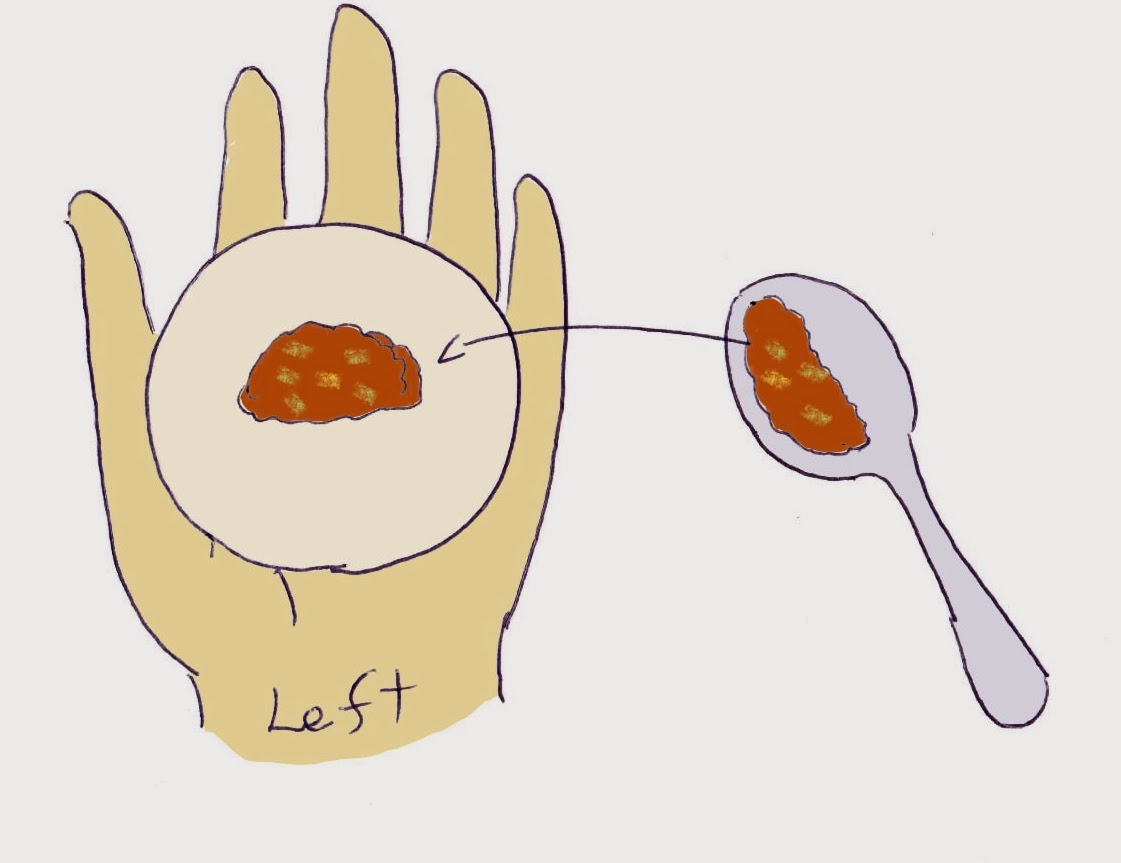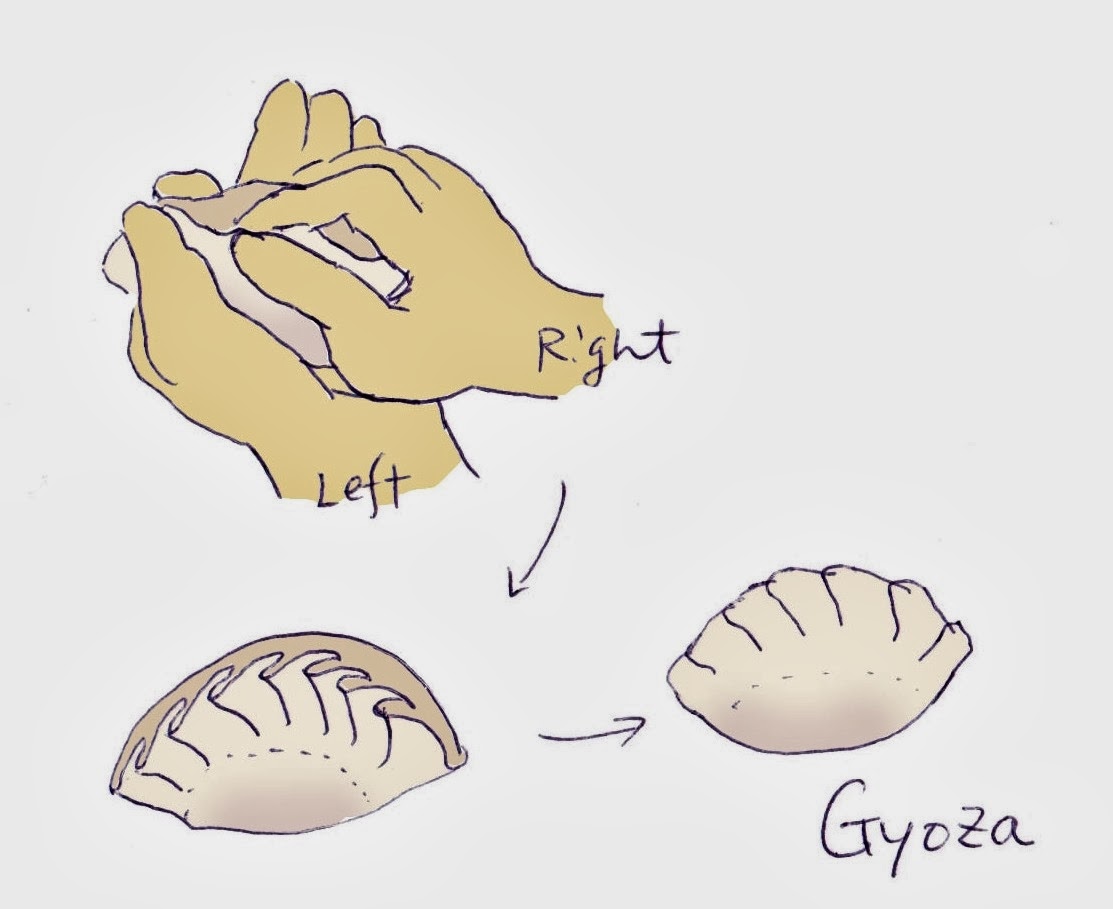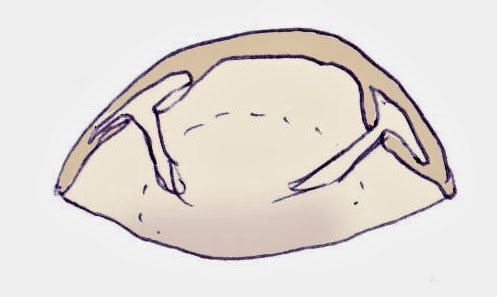Gyoza is a type of dumplings that is made based on Chinese dumplings: I heard that Chinese people prefer to have them boiled in soup, in Japan we definitely prefer this fried.
The original recipe has been adapted and twisted so the Japanese style recipes became so different at the end. When a Taiwanese friend looked at my recipe, he couldn't believe that I'm adding Miso in it.
The good Gyoza should be smooth and soft at the top skin by steam but crunchy at the bottom with a bit of browned skin. Dip it in the sauce and when you get a bite, the tasty meat with the juice comes out to your mouth .... mmm yummy.
Unfortunately this recipe requires some Asian specific ingredients. I described as many things as I could in related pages, hope it helps.
Ingredients (aprox. 40 Gyoza for serving 4 people)
2 packs of ready made dumpling pastry
(each pack usually contains 20-25 sheets, something like this)
b) 500 g minced pork
50 g white cabbage
b) 1 Tbsp ginger minced
b) 2-5 garlic cloves minced (I love a lot of garlic in but this is totally how much you can take)
b) 10 cm leak white part minced
b) 1 Tbsp soy sauce
b) 1 Tbsp sake
b) 2 tsp sesame oil
b) salt & black pepper
a) 1 Tbsp white miso
a) 1/2 tsp chicken soup powder (optional) + water from boiling cabbage
or
a) 1 cup chicken stock (optional)
Serving sauce
Soy sauce & sushi-zu (1 : 1)
few drops of chili oil (La-yu)
<Method>
0. If you buy a frozen dumpling pastry, you will need to leave it out at room temperature for half a day. If you are in hurry, you can put it in microwave to defroze them, but most likely you will lose 1 or 2 top and bottom sheets, it gets too hard on top and too soggy at the bottom.
1. Prepare the cabbage. Boil the cabbage in hot water. If you don't have chicken stock then keep a cup of water from the boiling cabbage. Drain the excess water out from boiled cabbage, mince them in about 5mm square. leave it aside.
2. Mix all listed with a) in a small cup. If you are using the cup of boiled water then mix the chicken soup powder first. If you are using chicken stock, warm up before mixing the miso in.
3. Put all listed with b) in a large bowl, then take minced cabbage in your hand, squeeze them well to drain out water, then put it in the bowl.
4. Mix them well using your hand; little by little adding the mixture of a) along with mixing them. The mixture start to get shinier and stickier, you can feel the fat start to melt. This is the key: you don't add all water, you add them until just the limit that you feel the mixture start to get little wet and cannot absorb any more liquid . If you added too much liquid, don't worry, just drain excess out.
5. Wrap the bowl with a plastic wrapping sheet then leave the mixture for at least 1 hour in the refrigerator.
6. Prepare to make dumplings. prepare a small dish of water, a tablespoon (or 2 tablespoons and a pair of another helping hands would do even better), dumpling pastry out from pack, 1 or 2 large plate half covered by plastic wrap in order to avoid your dumpling gets dried out and hard.
7. Make dumplings. You may think it's tricky, I say not necessary. Depends on how sophisticated way you make. Key here is, do not put too much mixture inside. The more mixture you put in the more difficult it is to close them up.
Keep in mind; the ultimate goals of doing this are 1) to make the Gyoza stand up so the bottom can sit on the frying pan when you cook, 2) to enclose the mixture in the Gyoza so the precious juice will remain until you put it into your mouth.
Wet the all outside border of the skin using your right hand finger, like picture.
I'll describe in 3 ways from here:
a. Now if you have no confidence at all, don't worry, just fold the pastry in half and close all side together well, then make it stand then PUSH down the center so dumpling can stand. This is what I do for my son.
b. If you want to try a bit better looking, then fold the pastry lightly in half, hold the top center together by right hand fingers, hold it, push up the side using the left hand finger and make a excess flap in front. Fold the flap downward and close the side well. Do the same to other side. This is simple to do, but also has a benefit, it contains more mixture inside than the regular shape.
c. At last, if you are already good at doing detail work, then make small overlap from one side to the other side. Basically you will keep the pastry on your left palm through time, fold them gently in half, sustaining the shape by left hand middle finger to pinkie finger and bottom of right hand thumb. Then, from left side end, fold backside and front side sheet together using the left hand pointing finger and thumb. While holding them together, gather up the next flap using the right hand thumb, overlap the flap on where left thumb is holding then hold them again using the left thumb. repeat this to make wave of flaps till the right side end.
8. Now frying the Gyoza. Place the frying pan on a hob with high heat, leave it until it gets enough hot. Turn down the heat to low, add about 1 Tbsp oil in, spread it through the pan then start placing Gyoza in few rows. heat up to high again, wait for 1=2 minutes, pick one at the side and check until the bottom start to get lightly browned. Now add water from outskirt of fry pan to cover about 1/3 of the Gyoza bottoms, then cap the frying pan to steam the Gyoza. Once the most of the water evaporated, take off the cap and take a look inside: if the skin is mostly transparent and can see through the pink colour of pork meat inside then it should be cooked enough; if not then add a bit more water and cap it for a while more.
9. Now leave the pan without the cap and continue frying for another minute, until the water is completely dry and start to form a fluffy burned skins around the Gyoza. Stop the fire, serve them on a dish. The sause is simply mixing the sushi vinegar and soy sauce, add some chili oil to spice up.
By the way, the bottom piece in the picture is a bit advanced from style b as below picture. I had the pastry only remained at the end, so wrapped some sliced baby onions, a bit of shredded chicken breast and mozzarella cheese.









No comments:
Post a Comment